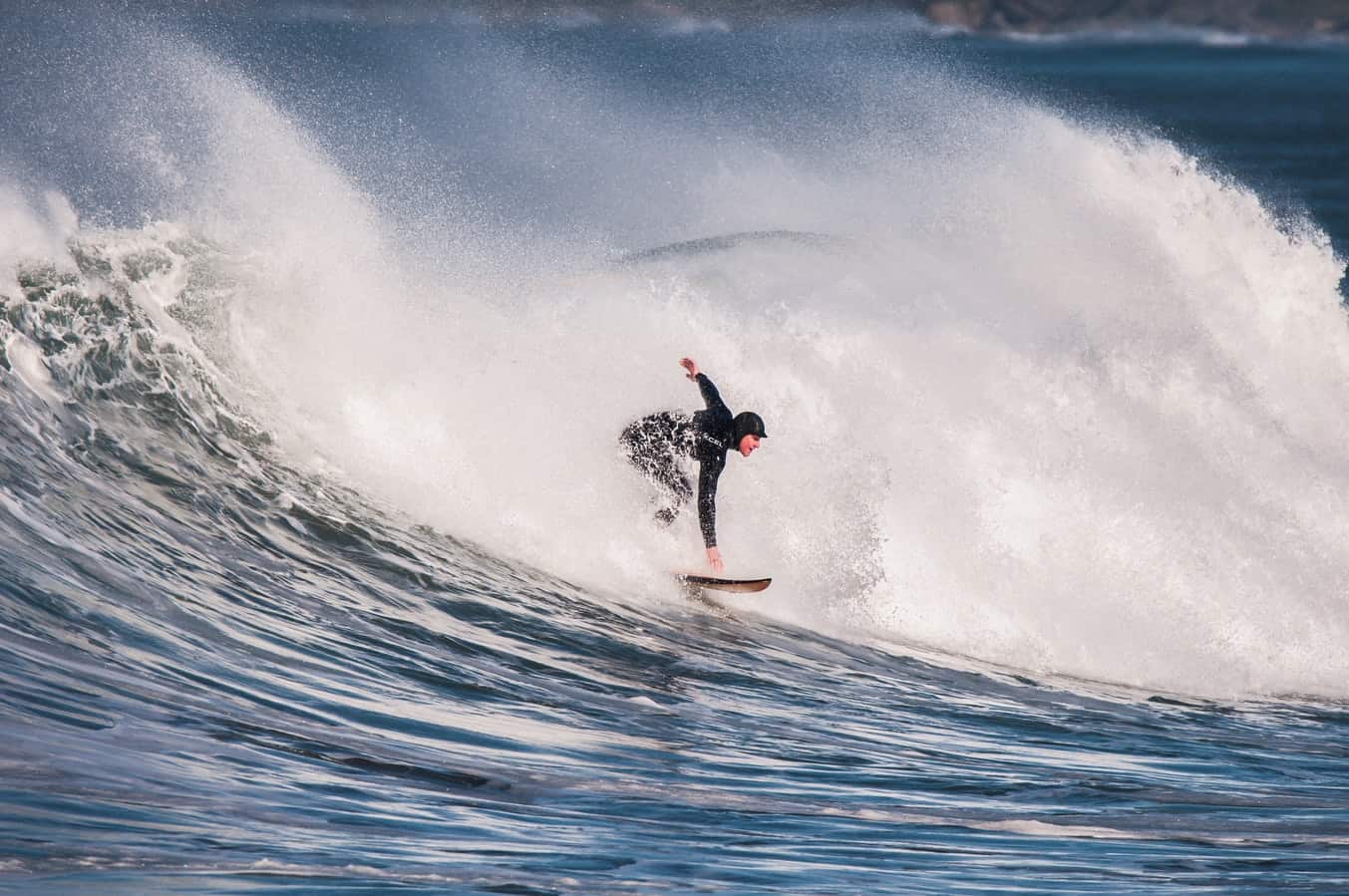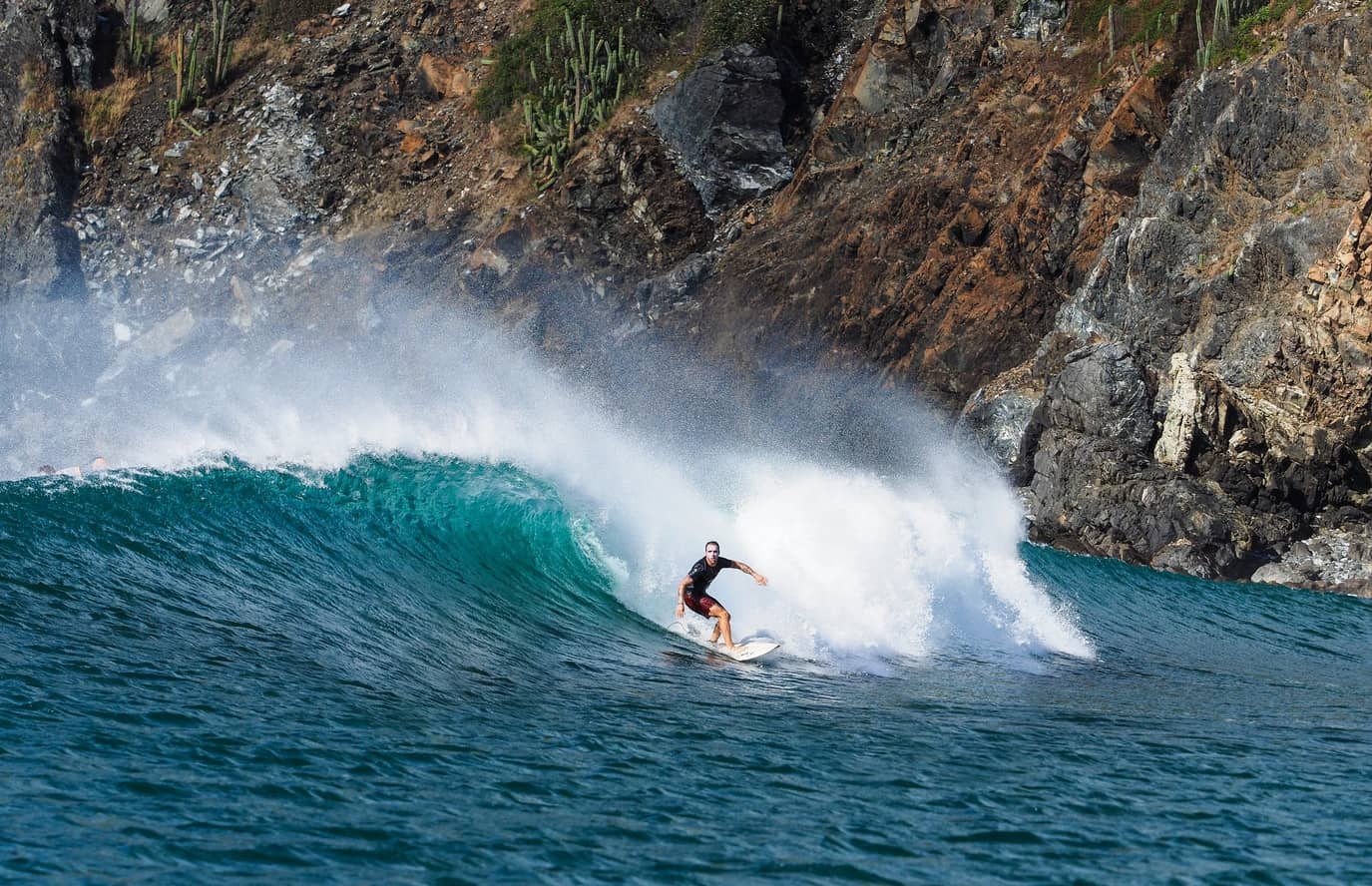Surfing terminology can seem like a language all its own. From describing the gear to the waves, surfers have created their own lexicon.
When it comes to surf spots, each locale has its own description based on its geography. But what are they and what do they mean? For instance, what is a point break and why does it matter? A point break refers to an area where the waves break against land that is perpendicular to the shore, like a jetty or peninsula.
A point break is one of several different types of surf breaks. Break refers to where the waves break.
In a point break, a piece of land sticks out from shore creating a point. When wave energy rolls toward the shore it hits the underwater topography of the point and sends the waves breaking around the land mass.
The bottom can be made of sand, reef or rocks. Point breaks can have waves that break either right or left, and sometimes in special cases waves break on both sides of a point.
Thanks to the land formation, point breaks have consistent waves and long rides. This is due to the fact that the point is fixed, instead of constantly moving like a sandbar. So you can count on wave formation with little fluctuation.
When the water reaches the jetty, the wave begins to crest to the inside of the point. As it crests, it peels all the way down the shoreline making for a great ride.
Some point breaks are known for gentle slow rides while others create more powerful hollow waves. Depending on the spot, these waves can be tricky to catch due to potential rocks and reefs near the takeoff spot, also something to watch out for if thrown from your board.
Best Point Break Locations For Surfing
Some of the most famous point breaks are Jeffrey’s Bay in South Africa, Malibu and Rincon in California, as well as Skeleton Bay in Namibia.
Jeffrey’s Bay
Jeffrey’s Bay, also known as J-Bay, is called the longest, most perfect right hand point break in the world.
It’s made of several sections including Boneyards and Supertubes, the location of plenty of professional surf competitions. The best time to go is during the winter, May – September for this southern hemisphere location.
Malibu
Once considered the epicenter of surfing innovation, in 2018 this surfspot became part of the National Register of Historic Places.
Malibu Point offers three take off spots, First Point, Second Point, and Third Point. First Point offers the most consistent waves while the other two are best at medium tide. This location tends to draw crowds, so you’ll have to wait your turn.
The best surf is during summer when you can expect south and south west swells coming through.
Rincon
Called the “Queen of the Coast”, Rincon is located between Santa Barbara and Ventura counties in California, though generally considered a Santa Barba spot.
Another right handed wave, this is considered one of the best that California has to offer and a must see for professional surfers like Kelly Slater and Tom Curren.
With three take offs, The Indicator, the Rivermouth and the Cove, there’s plenty for every surfer. Which is good as this location is popular and will get crowded.
The best time to visit is during winter when storms drum up the best swells. However, watch out for water pollution and contamination after storms, thanks to septic tank systems nearby.
As a rocky bottom break, watch out for scrapes if you fall from your board.
Skeleton Bay
Skeleton Bay is known as the best left hander point break there is.
Relatively new to the surf scene, Skeleton Bay was “discovered” around 2008 thanks to the Google Earth challenge by Surfer Magazine. This challenge involved using Google Earth to find the next best wave.
Since then surfers have come from all over the world to enjoy the epic long waves and multiple barrels this spot has to offer.
Skeleton Bay is unique in that its point is created by a large sandbar as most points are made by rock formations.
Point breaks are just one of four types. The other three surf breaks are beach breaks, reef breaks and river breaks. The most common is the beach break, while the river break is the least.
Beach Break
A beach break is where waves crest over a sandy bottom on the beach.
They form when the wave rolls up to the sandbar and the wave energy slows against it, causing the wave to topple itself. The general formula being that the waves crest when they reach a depth roughly half its height.
This often makes the waves unpredictable from week to week as the sand is ever moving thanks to currents, swell and tide. This makes them more unreliable in terms of speed and depth.
Depending on the sandbank, waves can be closeouts, right, left and even a-frames.
Beach breaks provide gentle rolling waves, perfect for beginners, as well as more powerful, hollow waves for advanced surfers. Which is good since by its nature, beach breaks are the most common in the world.
Thanks to its sandy bottom, this break is considered easier and more gentle when wiping out or hitting the ground, at least in comparison to reefs and rocks.
Due to this, as well as its soft waves, beach breaks are generally seen as the best place to learn to surf.

Where Are The Best Beach Breaks For Surfing?
Noteworthy beach breaks are Blacks Beach in San Diego, Nazare in Portugal and Hossegor in the southwest of France.
These three destinations are known as some of the best of their kind due to underwater canyons offshore, leading to greater shape and size when they reach the shore.
Blacks
Blacks is located in La Jolla, part of San Diego County. Thanks to its underwater canyon, waves here from into great peaks versus the closeouts you’d expect.
The best surfing here is found during winter when North and Northwest winds blow through. For smaller swells, low to medium tide is best, while larger swells are less affected by the tide at this surf spot.
Blacks is also known as the only nudist beach in San Diego, so don’t be surprised by the beachgoers here.
Nazare
Nazare, Portugal is like the holy grail of beach breaks.
It’s home to the biggest wave ever surfed. Ridden by Rodrigo Koxa in 2018, the wave was recorded at 80 feet, breaking the record previously held by Garret McNamera by two feet.
Nazare came to fame as a big wave surfing spot around the early 2000s and has since exploded in popularity.
The best time to go for big waves is during winter, but it offers milder waves during summer for surfers of all levels.
Hossegor
Hossegor is a famed surf spot in France. Known for beautiful barrels, the World Surf League holds competitions here every fall.
Summer offers warmer water and lighter winds and the winter offers greater swells. Again, the underwater canyon off the coast of Hossegor is the reason for its unbelievable waves.
What Is A Reef Break?
A reef break is where the waves break over a reef, both coral and rocky bottoms. You can find reef breaks close to shore, or far off shore breaking in the open water before fading out closer to shore.
Off shore breaks require a long swim or sometimes a tow out into the water to reach. A good example is Cortes Bank off the coast of California where the waves break over an underwater island.
This type of break is known for consistent, powerful waves as the reef is fixed, versus the moving sand of a beach break. Changes in these waves are more to do with swell and wind versus the seabed.
They also make for a more dangerous surfing experience.
Since a reef rises above the seafloor, waves breaking over it tend to be more shallow than other breaks, although some can be on the deeper side.
These shallow waves mean the risk of injury is also greater should you fall. It’s important to know how deep the reef is and where it is when surfing this kind of break.
Generally seen as a spot for more intermediate to advanced surfers, reef breaks are not for beginners.
Best Reef Breaks
Many of the most famous surf breaks in the world are reefs. They include Teahupo’o in Tahiti, Jaws in Hawaii and Cortes Bank in California.
Teahupo’o
Teahupo’o is also known as “The End of the Road”.
An ominous nickname as this is considered one of the most dangerous waves in the world thanks to its heavy force falling over a shallow reef. It’s also a popular destination for big wave surfers.
Jaws
Jaws, also known as Peahi, is one of the most notable spots in Hawaii.
Although known for big wave surfing, conditions here are often more mild in various times of the year. If looking for big waves, the best chances are November through March.
Cortes Bank
As mentioned, Cortes Bank is a reef in the open water around a hundred miles off the coast of California.
Accessible by boat, this is not your average surf spot. Surfing here is dangerous but still attempted by big wave surfers.
River Break
River breaks are pretty uncommon surf spots. They occur around the entrance of a river or creek, as well as where a lagoon or lake reaches the ocean.
River breaks also happen where the fast moving current is slowed by rocks, causing waves to break over.
They create left, right and even a-frame waves. This type of spot generally has sandy bottoms but there are some with rocks or reefs.
Best River Breaks
Mundaka in the Basque Country of northern Spain, as well as Bend Whitewater Park in Oregon are two of the most well known river breaks.
Mundaka
Mundaka offers a barrelling left hand wave, found in the north of Spain.
The best conditions are during Autumn but can be finicky. Although touted as the best rivermouth wave there is, it only has around fifty days of big swells per year.
Bend
Bend Whitewater Park of Bend, Oregon is one of the most popular river breaks there is.
Conditions here are surfable every day and there can be wait times of up to an hour to ride during the summer. A shallow wave, expect to hit bottom while learning this wave.
Related Questions
What Does a Left Hander Mean?
A left hander, or simply a left, refers to the direction the wave is going. Waves can be left, right, a-frame or closeouts.
Direction is dictated by the perspective of the surfer on the wave, so a left would look like a right from the beach.
What Is the Best Type of Surf Break?
Every type of break shows up on lists of the best waves. The best type of break is subjective and will depend on the weather conditions as well as the surfer.
In general breaks with fixed topography like reef breaks and point breaks are idolized due to their consistency. However a good day at a beach break is still better than a bad day at a reef.


